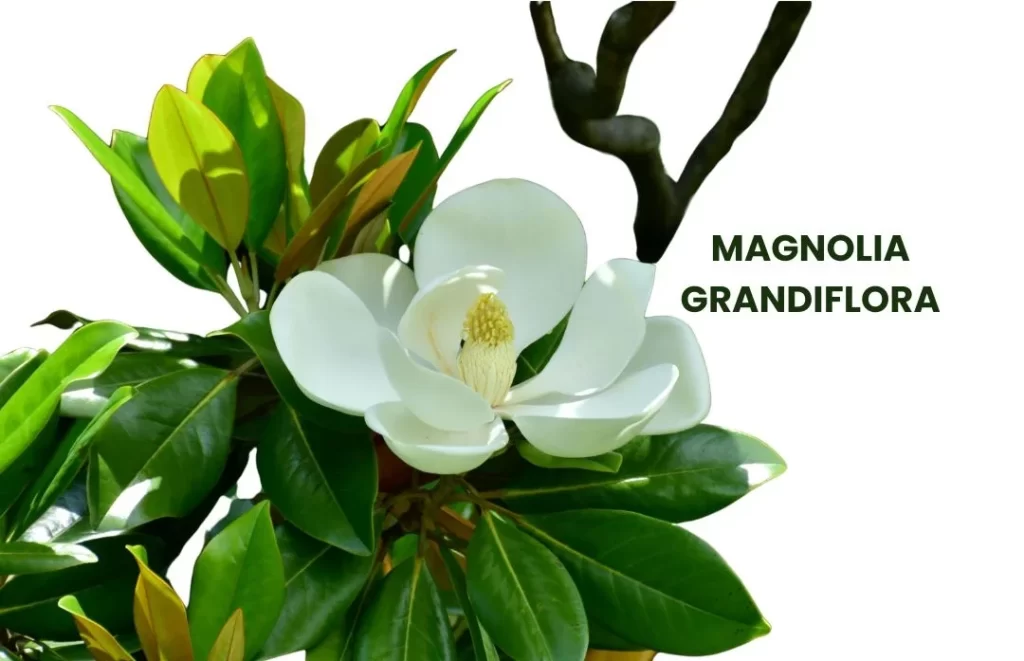Magnolia Grandiflora, commonly known as Magnolia, is a homeopathic remedy used to address symptoms primarily related to rheumatism and cardiac issues.
It is known for alleviating stiffness, soreness, and erratic pains.

SOURCE INFORMATION
Scientific Classification
- Kingdom: Plantae
- Clade: Angiosperms
- Clade: Magnoliids
- Order: Magnoliales
- Family: Magnoliaceae
- Genus: Magnolia
- Species: M. grandiflora
Historical Facts
- Origin: Derived from the magnolia tree, which has been used in traditional medicine for various ailments, particularly those involving the heart and rheumatism.
- Homeopathic Use: Introduced into homeopathy for its specific action on the musculoskeletal and cardiovascular systems.
DRUG PATHOGENESIS
- Primary Action: Magnolia Grandiflora primarily affects the musculoskeletal and cardiovascular systems, causing symptoms such as stiffness, soreness, and cardiac pains.
- Secondary Action: It also impacts the respiratory system, causing symptoms like dyspnea and a feeling of suffocation.
KEY CHARACTERISTICS
- Rheumatism: Stiffness and soreness in muscles and joints.
- Cardiac Issues: Symptoms related to the heart, including pain, oppression, and dyspnea.
PARTICULAR ORGAN SYMPTOMS
HEART
- Oppression of Chest: Inability to expand the lungs.
- Feeling of Bolus: Sensation of a large bolus of food causing distress in the stomach.
- Suffocated Feeling: When walking fast or lying on the left side.
- Dyspnea: Difficulty in breathing.
- Crampy Pain: In the heart, angina pectoris.
- Endocarditis and Pericarditis: Inflammation of the heart lining.
- Fainting Tendency: Sensation as if the heart had stopped beating.
- Pains Around Heart: Accompanied by itching of the feet.
EXTREMITIES
- Stiffness: Sharp erratic pains, worse in joints.
- Feet Itch: Numbness in the left arm.
- Rheumatic Pain: In clavicles.
- Shooting Pains: In all limbs.
MODALITIES
Worse from
- Damp air
- Lying on left side
- In the morning on first rising
Better from
- Dry weather
- Motion
- Intermenstrual flow (compared with Hamamelis, Bovista, Belladonna, Elaps)
WHAT ARE MODALITIES IN HOMOEOPATHY?
RELATIONSHIP WITH OTHER DRUGS
Compare with
- Rhus Toxicodendron: Known for treating rheumatism and skin conditions.
- Dulcamara: Used for symptoms aggravated by damp weather.
- Aurum Metallicum: Effective for heart conditions and depression.
DOSE
- Potency: Typically used in the third potency (3C).
- Dosage: The exact dosage and frequency should be determined by a homeopathic practitioner based on individual symptoms and response to treatment.
Frequently Asked Questions
What are the main indications for Magnolia Grandiflora?
- Magnolia Grandiflora is primarily indicated for rheumatism, cardiac issues, stiffness, soreness, and erratic pains.
How should Magnolia Grandiflora be taken?
- It is usually taken in the third potency (3C).
- The exact dosage should be determined by a homeopathic practitioner.
Are there any side effects of using Magnolia Grandiflora?
- In homeopathic doses, side effects are rare.
- However, if symptoms worsen or new symptoms appear, it is advisable to consult with a homeopathic practitioner.
Can Magnolia Grandiflora be used alongside conventional medications?
- Yes, but it is important to inform your healthcare provider and homeopathic practitioner about all the medications and treatments you are currently using to avoid potential interactions.
What should I do if I experience worsening symptoms?
- If symptoms worsen, contact a homeopathic practitioner or healthcare provider to reassess the treatment plan.
Magnolia Grandiflora is a versatile homeopathic remedy addressing a range of symptoms, particularly those related to rheumatism and cardiac issues.
Always consult with a qualified homeopathic practitioner for personalized treatment and dosage.
